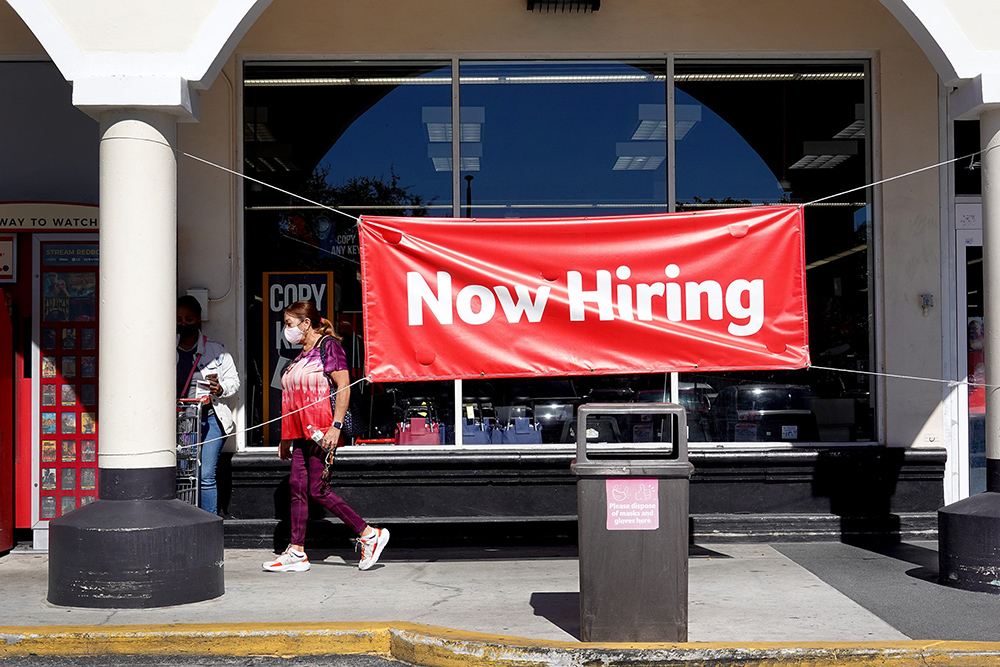
想要实现软着陆吗?试试推进性别平等议程。通过缩小美国劳动力市场的性别平等差距,可以帮助政策制定者实现梦寐以求的软着陆。这样做,我们可以从公平的劳动力市场中获得1.789万亿美元的收益。
当我们通过交叉性视角来看待经济时——也就是说,当我们按性别加上种族和民族来分列经济数据时,有趣的事情发生了。就在疫情爆发之前,女性的劳动参与率已攀升至59.2%。截至2022年10月的就业报告,这一比例已降至58%。当我们从控制人口增长的百分比角度考虑这一问题时,这意味着自2020年2月以来,有154.9万女性从劳动力大军中消失了。
这让我感到不安,而我的不安不是来自公平问题。我不是激进分子。我是一名性别经济学家——我们的经济实力源于劳动力大军的多元化。我们需要那一百多万从劳动力大军中消失的女性来为我们的经济引擎注入动力。自1970年以来,女性通过提高劳动力参与率为美国经济贡献了2万亿美元的价值。
以万亿美元计的经济机会被疫情抹杀了
在疫情爆发之前,缩小劳动力参与率方面的性别差距可以为美国经济带来约7890亿美元的收益,而除此之外,自1970年以来,我们已经获得了2万亿美元的收益。
然而,在过去的两年时间里,29年来在劳动力市场性别平等方面取得的进展付之东流。这种倒退潜在上使美国经济损失了1.789万亿美元。换句话说,缩小劳动力市场上的性别平等差距可以为疫情后的美国经济提供1.789万亿美元的支撑。
如果我们在10月份的失业数据中计入劳动力市场中缺失的154.9万女性,那么女性的实际失业率将为5.42%。通过交叉性视角,情况看起来要暗淡得多。对非裔女性来说,包括自2020年2月以来从劳动力市场上消失的32.8万名非裔女性,失业率为8.58%。对拉丁裔来说,包括自2020年2月以来从劳动力市场上消失的31.3万女性,失业率为6.03%。我们的政策不仅没有考虑到这些女性,而且也不太了解她们离开劳动力市场的原因。我们无法获得相关数据——但经济学家确实怀疑其中许多人进入了非正规经济。
这些令人眩晕的交叉失业率不仅与美联储实现最大充分就业的目标相悖(目标失业率在4.1%到4.7%之间),也与经济繁荣原则相悖。
如果我们不是通过大幅加息来给经济降温,而是通过制定解决方案让这些女性重返劳动力市场呢?这样做将得到一个应对软着陆挑战的三步走方案:该方案将稳定物价,鼓励公平就业,并促进经济可持续增长。
性别平等是实现经济软着陆的关键
实现软着陆需要遵循三步走原则。让我们回顾一下这一舞蹈的编排。
首先,经济升温,通货膨胀上升。10月份的物价较上年同期上涨7.7%。
其次,美联储加息,给经济降温。美联储在短短8个月内将联邦基金利率提高了375个基点。
第三,物价维持稳定,避免经济衰退。如果我们选择让这154.9万女性重返劳动力市场,我们就有希望实现软着陆。原因如下。
公平就业带来的经济效益
在美国经济中,每个找工作的人都对应有约两个空缺职位。劳动力供给增加将使员工与空缺职位之间的差距缩小近33%。通过减轻工资-物价螺旋上升带来的有害影响,更多的员工争抢不断减少的工作机会,这将有助于抑制通货膨胀。
为了避免经济衰退,需要将所有交叉群体的失业率保持在4.1%到4.7%的最大充分就业的目标范围内。正如按性别和种族分列的数据所显示的那样,有意让非裔和拉丁裔女性重返劳动力市场,将确保在一个已经显现出最严重的经济分层的国家,不会出现持久的K型复苏。
总体而言,进一步加息对公平就业来说不是好兆头。紧缩的货币政策导致公司按照“后进先出”的原则整合劳动力。这意味着女性和非裔雇员通常是最先被解雇的。
新的研究表明,从公平的劳动力市场中获得1.789万亿美元的收益是一个保守的预测,因为用来计算这一数字的模型依赖于所谓的职员总数衡量方法。它对每个“人头”都一视同仁。一位员工就是一位员工。
然而,在劳动力市场上,女性和男性并没有完美的替代品。增加一个特定业务部门的性别多样性会改善公司的财务业绩,而这种改善是模型无法体现的。
例如,我所在的公司的研究表明,交叉性的性别平等每增加10%,收入就会增加1-2%。当模型将性别平等考虑在内时,女性劳动力贡献的经济收益可能多达五分之一。(财富中文网)
本文作者卡蒂卡·罗伊(Katica Roy)是Pipeline公司的首席执行官。
Fortune.com上发表的评论文章中表达的观点,仅代表作者本人观点,不代表《财富》杂志的观点和立场。
译者:中慧言-王芳
想要实现软着陆吗?试试推进性别平等议程。通过缩小美国劳动力市场的性别平等差距,可以帮助政策制定者实现梦寐以求的软着陆。这样做,我们可以从公平的劳动力市场中获得1.789万亿美元的收益。
当我们通过交叉性视角来看待经济时——也就是说,当我们按性别加上种族和民族来分列经济数据时,有趣的事情发生了。就在疫情爆发之前,女性的劳动参与率已攀升至59.2%。截至2022年10月的就业报告,这一比例已降至58%。当我们从控制人口增长的百分比角度考虑这一问题时,这意味着自2020年2月以来,有154.9万女性从劳动力大军中消失了。
这让我感到不安,而我的不安不是来自公平问题。我不是激进分子。我是一名性别经济学家——我们的经济实力源于劳动力大军的多元化。我们需要那一百多万从劳动力大军中消失的女性来为我们的经济引擎注入动力。自1970年以来,女性通过提高劳动力参与率为美国经济贡献了2万亿美元的价值。
以万亿美元计的经济机会被疫情抹杀了
在疫情爆发之前,缩小劳动力参与率方面的性别差距可以为美国经济带来约7890亿美元的收益,而除此之外,自1970年以来,我们已经获得了2万亿美元的收益。
然而,在过去的两年时间里,29年来在劳动力市场性别平等方面取得的进展付之东流。这种倒退潜在上使美国经济损失了1.789万亿美元。换句话说,缩小劳动力市场上的性别平等差距可以为疫情后的美国经济提供1.789万亿美元的支撑。
如果我们在10月份的失业数据中计入劳动力市场中缺失的154.9万女性,那么女性的实际失业率将为5.42%。通过交叉性视角,情况看起来要暗淡得多。对非裔女性来说,包括自2020年2月以来从劳动力市场上消失的32.8万名非裔女性,失业率为8.58%。对拉丁裔来说,包括自2020年2月以来从劳动力市场上消失的31.3万女性,失业率为6.03%。我们的政策不仅没有考虑到这些女性,而且也不太了解她们离开劳动力市场的原因。我们无法获得相关数据——但经济学家确实怀疑其中许多人进入了非正规经济。
这些令人眩晕的交叉失业率不仅与美联储实现最大充分就业的目标相悖(目标失业率在4.1%到4.7%之间),也与经济繁荣原则相悖。
如果我们不是通过大幅加息来给经济降温,而是通过制定解决方案让这些女性重返劳动力市场呢?这样做将得到一个应对软着陆挑战的三步走方案:该方案将稳定物价,鼓励公平就业,并促进经济可持续增长。
性别平等是实现经济软着陆的关键
实现软着陆需要遵循三步走原则。让我们回顾一下这一舞蹈的编排。
首先,经济升温,通货膨胀上升。10月份的物价较上年同期上涨7.7%。
其次,美联储加息,给经济降温。美联储在短短8个月内将联邦基金利率提高了375个基点。
第三,物价维持稳定,避免经济衰退。如果我们选择让这154.9万女性重返劳动力市场,我们就有希望实现软着陆。原因如下。
公平就业带来的经济效益
在美国经济中,每个找工作的人都对应有约两个空缺职位。劳动力供给增加将使员工与空缺职位之间的差距缩小近33%。通过减轻工资-物价螺旋上升带来的有害影响,更多的员工争抢不断减少的工作机会,这将有助于抑制通货膨胀。
为了避免经济衰退,需要将所有交叉群体的失业率保持在4.1%到4.7%的最大充分就业的目标范围内。正如按性别和种族分列的数据所显示的那样,有意让非裔和拉丁裔女性重返劳动力市场,将确保在一个已经显现出最严重的经济分层的国家,不会出现持久的K型复苏。
总体而言,进一步加息对公平就业来说不是好兆头。紧缩的货币政策导致公司按照“后进先出”的原则整合劳动力。这意味着女性和非裔雇员通常是最先被解雇的。
新的研究表明,从公平的劳动力市场中获得1.789万亿美元的收益是一个保守的预测,因为用来计算这一数字的模型依赖于所谓的职员总数衡量方法。它对每个“人头”都一视同仁。一位员工就是一位员工。
然而,在劳动力市场上,女性和男性并没有完美的替代品。增加一个特定业务部门的性别多样性会改善公司的财务业绩,而这种改善是模型无法体现的。
例如,我所在的公司的研究表明,交叉性的性别平等每增加10%,收入就会增加1-2%。当模型将性别平等考虑在内时,女性劳动力贡献的经济收益可能多达五分之一。(财富中文网)
本文作者卡蒂卡·罗伊(Katica Roy)是Pipeline公司的首席执行官。
Fortune.com上发表的评论文章中表达的观点,仅代表作者本人观点,不代表《财富》杂志的观点和立场。
译者:中慧言-王芳
Want to stick a soft landing? Try sticking to an agenda of gender equity. By closing the gender equity gap in the U.S. labor market, we can achieve the coveted soft landing policy leaders are striving for. And in doing so, we can reap the $1.789 trillion upside of labor market equity.
Something fascinating happens when we view the economy through the intersectional gender lens–that is, when we disaggregate economic data by gender plus race and ethnicity. Right before the pandemic hit, women’s labor force participation rate had climbed to 59.2%. As of the October 2022 jobs report, the rate had dropped to 58%. When we deal in percentages that control for population growth, that means 1.549 million women have vanished from the labor force since February 2020.
This bothers me, and not for reasons of fairness. I’m not an activist. I’m a gender economist–and our economy derives its strength from the plurality of the labor base. We need those million-plus lost women to power our economic engine. Since 1970, women have added $2 trillion of value to the U.S. economy by increasing their labor force participation.
A trillion-dollar economic opportunity obliterated by the pandemic
Pre-pandemic, closing the gender gap in labor force participation could have yielded some $789 billion for the U.S. economy on top of the $2 trillion we’ve already gained since 1970.
However, in the last two years, 29 years of progress toward gender equity in the labor market has been obliterated. This regression has cost the U.S. $1.789 trillion in economic potential. In other words, closing the gender equity gap in the labor market could bolster the post-pandemic US economy by $1.789 trillion.
If we include the 1.549 million missing women from the labor market in October’s unemployment figures, women’s real unemployment rate would be 5.42%. The picture looks much bleaker through the intersectional lens. For Black women, including the 328,000 of them missing from the labor force since February 2020, the unemployment rate is 8.58%. For Latinas, including the 313,000 of them missing from the labor force since February 2020, the unemployment rate is 6.03%. Not only do our policies fail to take these women into account, but we also don’t know much about the reasons they left the workforce. The data is simply not available–but economists do suspect many of them went into the informal economy.
Not only do these vertiginous intersectional unemployment rates violate the Fed’s mandate of maximum employment (of which the target unemployment rate ranges between 4.1% and 4.7%), they also violate the principles of economic prosperity.
What if instead of yanking interest rates to cool down the economy, we craft solutions to bring these women back into the workforce? Doing so would generate a tripartite solution to the soft landing challenge: it would stabilize prices, encourage equitable employment, and fuel sustainable economic growth.
Gender equity is key to a soft landing
A soft landing follows a three-step dance. Let’s review the choreography.
First, the economy heats up and inflation rises. October’s prices were up 7.7% compared to the previous year.
Second, the Fed raises interest rates to cool down the economy. The Fed has raised the federal funds rate by 375 basis points in only eight months.
Third, prices stabilize and the economy avoids a recession. If we choose to bring those 1.549 million women back into the labor force, we can hope for a soft landing. Here’s why.
The economic benefits of equitable employment
Our economy has approximately two open jobs for every person looking for work. An expanded labor base would close the worker-to-open-job gap by nearly 33%. More workers chasing fewer jobs would keep inflation in check by mitigating the harmful effects of the wage-price spiral.
To avoid a recession, we need to keep unemployment for all intersectional cohorts within the maximum employment mandate range of 4.1% and 4.7%. As the gender and race disaggregated data show, bringing Black and Latina women meaningfully back into the workforce would ensure we don’t have a protracted k-shaped recovery in a country already exhibiting some of its most egregious levels of economic stratification.
Further interest rate hikes do not bode well for equitable employment levels in general. Tighter monetary policy causes companies to consolidate their workforces to the rhythm of “last hired, first fired.” And that means women and Black employees are usually the first to get cut.
Emerging research suggests the $1.789 trillion upside of labor market equity is a conservative projection–because the models used to calculate that figure rely on what’s known as a headcount measurement. It treats every “head” the same. A worker is a worker.
However, women and men are not perfect substitutes in the labor market. Increasing the gender diversity of a given business unit leads to improved financial performance of the firm in a way not captured by the models.
For instance, my company’s research shows that every 10% increase in intersectional gender equity yields a 1-2% increase in revenue. When models do account for gender equity, the economic gains of women’s labor force participation could be up to a fifth larger.
Katica Roy is the CEO of Pipeline.
The opinions expressed in Fortune.com commentary pieces are solely the views of their authors and do not necessarily reflect the opinions and beliefs of Fortune.






